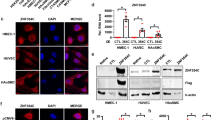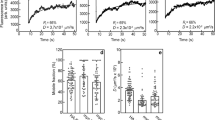Abstract
Early growth response 3 (Egr3) is a member of a zinc-finger transcription factor subfamily, which we previously found to be strongly upregulated by vascular endothelial growth factor (VEGF)-A in an oligonucleotide microarray screen of endothelial cells. Here, we show that Egr3 is the predominant Egr family member upregulated by VEGF in endothelial cells at 45 min, and that VEGF induced a rapid increase in Egr-dependent transcriptional activation mediated via its major signalling receptor, VEGFR2/KDR, and the protein kinase C (PKC) pathway. VEGF-induced Egr3 gene expression was also mediated in part via a PKC-dependent activation of protein kinase D. Inhibition of Egr3 gene expression by RNA interference was effective in inhibiting basal and VEGF-induced Egr3 gene expression, and it also inhibited VEGF-mediated endothelial cell proliferation, migration and tubulogenesis. These findings indicate that Egr3 has an essential downstream role in VEGF-mediated endothelial functions leading to angiogenesis and may have particular relevance for adult angiogenic processes involved in vascular repair and neovascular disease.
This is a preview of subscription content, access via your institution
Access options
Subscribe to this journal
Receive 50 print issues and online access
$259.00 per year
only $5.18 per issue
Buy this article
- Purchase on Springer Link
- Instant access to full article PDF
Prices may be subject to local taxes which are calculated during checkout






Similar content being viewed by others
References
Abe M, Sato Y . (2001). cDNA microarray analysis of the gene expression profile of VEGF-activated human umbilical vein endothelial cells. Angiogenesis 4: 289–298.
Abedi H, Zachary I . (1997). Vascular endothelial growth factor stimulates tyrosine phosphorylation and recruitment to new focal adhesions of focal adhesion kinase and paxillin in endothelial cells. J Biol Chem 272: 15442–15451.
Abu-Ghazaleh R, Kabir J, Jia H, Lobo M, Zachary I . (2001). Src mediates vascular endothelial growth factor (VEGF) stimulation of focal adhesion kinase (FAK) phosphorylation at tyrosine 861, migration, and anti-apoptosis in endothelial cells. Biochem J 360: 255–264.
Arkenbout EK, van Bragt M, Eldering E, van Bree C, Grimbergen JM, Quax PH et al. (2003). TR3 orphan receptor is expressed in vascular endothelial cells and mediates cell cycle arrest. Arterioscler Thromb Vasc Biol 23: 1535–1540.
Carmeliet P, Jain R . (2003). Angiogenesis in health and disease. Nat Med 9: 653–660.
Carter JH, Tourtellotte WG . (2007). Early growth response transcriptional regulators are dispensable for macrophage differentiation. J Immunol 17: 3038–3047.
Dougher M, Terman BI . (1999). Autophosphorylation of KDR in the kinase domain is required for maximal VEGF-stimulated kinase activity and receptor internalization. Oncogene 18: 1619–1627.
Fahmy RG, Dass CR, Sun LQ, Chesterman CN, Khachigian LM . (2003). Transcription factor Egr-1 supports FGF-dependent angiogenesis during neovascularization and tumor growth. Nat Med 9: 1026–1032.
Ferrara N, Gerber H-P, LeCouter J . (2003). The biology of VEGF and its receptors. Nat Med 9: 669–676.
Gerber HP, McMurtrey A, Kowalski J, Yan M, Keyt BA, Dixit V et al. (1998). Vascular endothelial growth factor regulates endothelial cell survival through the phosphatidylinositol 3′-kinase/Akt signal transduction pathway. Requirement for Flk-1/KDR activation. J Biol Chem 273: 30336–30343.
Gliki G, Abu-Ghazaleh R, Jezequel S, Wheeler-Jones C, Zachary I . (2001). Vascular endothelial growth factor-induced prostacylin production is mediated by a protein kinase C (PKC)-dependent activation of extracellular signal-regulated protein kinases 1 and 2 involving PKC-δ and by mobilization of intracellular Ca2+. Biochem J 353: 503–512.
Inoue A, Omoto Y, Yamaguchi Y, Kiyama R, Hayashi SI . (2004). Transcription factor Egr3 is involved in the estrogen-signaling pathway in breast cancer cells. J Mol Endocrinol 32: 649–661.
Jia H, Jezequel S, Löhr M, Shaikh S, Davis D, Soker S et al. (2001). Peptides encoded by exon 6 of VEGF inhibit endothelial cell biological responses and angiogenesis induced by VEGF. Biochem Biophys Res Commun 283: 164–173.
Laitinen M, Zachary I, Breier G, Pakkanen T, Hakkinen T, Luoma J et al. (1997). VEGF gene transfer reduces intimal thickening via increased production of nitric oxide in carotid arteries. Hum Gene Ther 8: 1737–1744.
Levkovitz Y, O'Donovan KJ, Baraban JM . (2001). Blockade of NGF-induced neurite outgrowth by a dominant-negative inhibitor of the Egr family of transcription regulatory factors. J Neurosci 21: 45–52.
Liu D, Jia H, Holmes DI, Stannard A, Zachary I . (2003). Vascular endothelial growth factor-regulated gene expression in endothelial cells: KDR-mediated induction of Egr3 and the related nuclear receptors Nur77, Nurr1, and Nor1. Arterioscler Thromb Vasc Biol 23: 2002–2007.
Mercier G, Turque N, Schumacher M . (2001). Early activation of transcription factor expression in Schwann cells by progesterone. Brain Res Mol Brain Res 97: 137–148.
Neufeld G, Cohen T, Gengrinovitch S, Poltorak Z . (1999). Vascular endothelial growth factor (VEGF) and its receptors. FASEB J 13: 9–22.
O'Donovan KJ, Tourtellotte WG, Millbrandt J, Baraban JM . (1999). The Egr family of transcription-regulatory factors: progress at the interface of molecular and systems neuroscience. Trends Neurosci 22: 167–173.
O'Donovan KJ, Wilkens EP, Baraban JM . (1998). Sequential expression of Egr-1 and Egr-3 in hippocampal granule cells following electroconvulsive stimulation. J Neurochem 70: 1241–1248.
Patwardhan S, Gashler A, Siegel MG, Chang LC, Joseph LJ, Shows TB et al. (1991). Egr3, a novel member of the Egr family of genes encoding immediate-early transcription factors. Oncogene 6: 917–928.
Qin L, Zeng H, Zhao D . (2006). Requirement of protein kinase D tyrosine phosphorylation for VEGF-A165-induced angiogenesis through its interaction and regulation of phospholipase Cgamma phosphorylation. J Biol Chem 281: 32550–32558.
Rey O, Young SH, Cantrell D, Rozengurt E . (2001). Rapid protein kinase D translocation in response to G protein-coupled receptor activation. Dependence on protein kinase C. J Biol Chem 276: 32616–32626.
Safford M, Collins S, Lutz MA, Allen A, Huang CT, Kowalski J et al. (2005). Egr-2 and Egr-3 are negative regulators of T-cell activation. Nat Immunol 6: 472–480.
Silverman ES, Collins T . (1999). Pathways of Egr-1-mediated gene transcription in vascular biology. Am J Pathol 154: 665–670.
Takahashi T, Yamaguchi S, Chida K, Shibuya M . (2001). A single autophosphorylation site on KDR/Flk-1 is essential for VEGF-A-dependent activation of PLC-γ and DNA synthesis in vascular endothelial cells. EMBO J 20: 2768–7278.
Tourtellotte WG, Keller-Peck C, Milbrandt J, Kucera J . (2001). The transcription factor Egr3 modulates sensory axon-myotube interactions during muscle spindle morphogenesis. Dev Biol 232: 388–399.
Tourtellotte WG, Milbrandt J . (1998). Sensory ataxia and muscle spindle agenesis in mice lacking the transcription factor Egr3. Nat Genet 20: 87–91.
Waltenberger J, Claesson Welsh L, Siegbahn A, Shibuya M, Heldin CH . (1994). Different signal transduction properties of KDR and Flt1, two receptors for vascular endothelial growth factor. J Biol Chem 269: 26988–26995.
Wheeler-Jones C, Abu-Ghazaleh R, Cospedal R, Houliston RA, Martin J, Zachary I . (1997). Vascular endothelial growth factor stimulates prostacyclin production and activation of cytosolic phospholipase A2 in endothelial cells via p42/p44 mitogen-activated protein kinase. FEBS Lett 420: 28–32.
Wong C, Jin Z . (2005). Protein kinase C-dependent protein kinase D activation modulates ERK signal pathway and endothelial cell proliferation by vascular endothelial growth factor. J Biol Chem 280: 33262–33269.
Xi H, Kersh GJ . (2004a). Sustained early growth response gene 3 expression inhibits the survival of CD4/CD8 double-positive thymocytes. J Immunol 173: 340–348.
Xi H, Kersh GJ . (2004b). Early growth response gene 3 regulates thymocyte proliferation during the transition from CD4−CD8− to CD4+CD8+. J Immunol 172: 964–971.
Xi H, Schwartz R, Engel I, Murre C, Kersh GJ . (2006). Interplay between RORgammat, Egr3, and E proteins controls proliferation in response to pre-TCR signals. Immunity 24: 813–826.
Xia P, Aiello LP, Ishii H, Jiang ZY, Park DJ, Robinson GS et al. (1996). Characterization of vascular endothelial growth factor's effect on the activation of protein kinase C, its isoforms, and endothelial cell growth. J Clin Invest 98: 2018–2026.
Zachary I . (2003). VEGF signalling: integration and multitasking in endothelial cel biology. Biochem Soc Trans 31: 1171–1177.
Zeng H, Qin L, Zhao D, Tan X, Manseau EJ, Van Hoang M et al. (2006). Orphan nuclear receptor TR3/Nur77 regulates VEGF-A-induced angiogenesis through its transcriptional activity. J Exp Med 203: 719–729.
Zugaza JL, Sinnett-Smith J, Van Lint J, Rozengurt E . (1996). Protein kinase D (PKD) activation in intact cells through a protein kinase C-dependent signal transduction pathway. EMBO J 15: 6220–6230.
Acknowledgements
This work was funded by British Heart Foundation Programme Grant RG/06/003/21131 and Ark Therapeutics Ltd.
Author information
Authors and Affiliations
Corresponding author
Rights and permissions
About this article
Cite this article
Liu, D., Evans, I., Britton, G. et al. The zinc-finger transcription factor, early growth response 3, mediates VEGF-induced angiogenesis. Oncogene 27, 2989–2998 (2008). https://doi.org/10.1038/sj.onc.1210959
Received:
Revised:
Accepted:
Published:
Issue Date:
DOI: https://doi.org/10.1038/sj.onc.1210959



